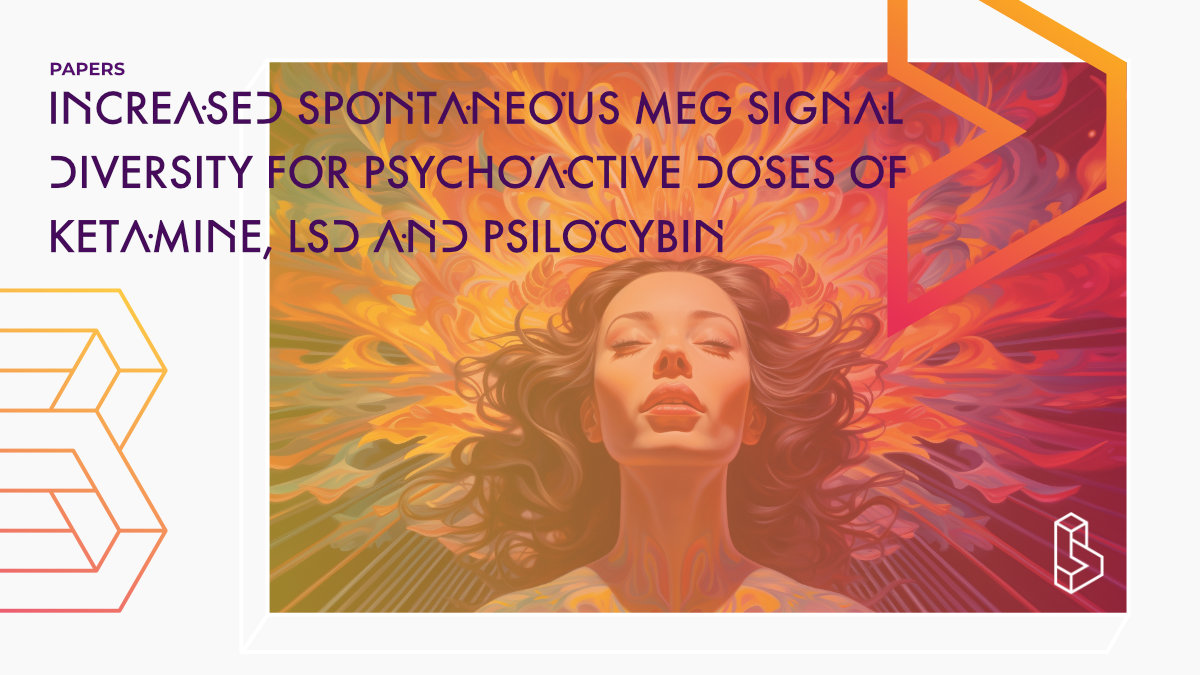This computational modelling study re-analysed data of multidimensional spontaneous MEG recordings collected during the administration of LSD, psilocybin, and ketamine during resting-state compared to the placebo condition. Results indicate that the intensity of psychedelic states corresponds to increased brain-wide signal diversity, as compared to placebo, across a range of measures and three different psychedelic compounds.
Abstract of Increased spontaneous MEG signal diversity for psychoactive doses of ketamine, LSD and psilocybin
“Introduction: What is the level of consciousness of the psychedelic state? Empirically, measures of neural signal diversity such as entropy and Lempel-Ziv (LZ) complexity score higher for wakeful rest than for states with lower conscious level like propofol-induced anesthesia.
Methods: Here we compute these measures for spontaneous magnetoencephalographic (MEG) signals from humans during altered states of consciousness induced by three psychedelic substances: psilocybin, ketamine and LSD.
Results: For all three, we find reliably higher spontaneous signal diversity, even when controlling for spectral changes. This increase is most pronounced for the single-channel LZ complexity measure, and hence for temporal, as opposed to spatial, signal diversity. We also uncover selective correlations between changes in signal diversity and phenomenological reports of the intensity of psychedelic experience.
Discussion: This is the first time that these measures have been applied to the psychedelic state and, crucially, that they have yielded values exceeding those of normal waking consciousness. These findings suggest that the sustained occurrence of psychedelic phenomenology constitutes an elevated level of consciousness – as measured by neural signal diversity.”
Authors: Michael M. Schartner, Robin L. Carhart-Harris, Adam B. Barrett, Anil K. Seth & Suresh D. Muthukumaraswamy
Summary of Increased spontaneous MEG signal diversity for psychoactive doses of ketamine, LSD and psilocybin
Understanding the brain’s basis of consciousness remains one of the outstanding challenges in modern science. Recent neuroscientific research has focused on uncovering differences in brain activity between closely matched conscious and unconscious perception, while conscious level is maintained constant.
Recently, growing interest has been in characterising how conscious level and conscious content may relate. One empirical approach is to apply emerging measures of conscious level to experimental manipulations that primarily affect conscious content.
The perturbational complexity index (PCI) measures the diversity across channels and observations of the EEG response to a transcranial magnetic stimulation (TMS) pulse and has been shown to robustly index levels of consciousness.
Find this paper
Increased spontaneous MEG signal diversity for psychoactive doses of ketamine, LSD and psilocybin
https://doi.org/10.1038/srep46421
Open Access | Google Scholar | Backup | 🕊
Cite this paper (APA)
Schartner, M. M., Carhart-Harris, R. L., Barrett, A. B., Seth, A. K., & Muthukumaraswamy, S. D. (2017). Increased spontaneous MEG signal diversity for psychoactive doses of ketamine, LSD and psilocybin. Scientific reports, 7(1), 46421.
Study details
Compounds studied
Ketamine
LSD
Psilocybin
Topics studied
Neuroscience
Study characteristics
Meta-Analysis
Placebo-Controlled
Bio/Neuro
Authors
Authors associated with this publication with profiles on Blossom
Robin Carhart-HarrisDr. Robin Carhart-Harris is the Founding Director of the Neuroscape Psychedelics Division at UCSF. Previously he led the Psychedelic group at Imperial College London.

